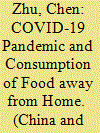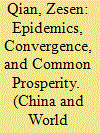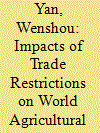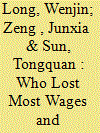|
|
|
Sort Order |
|
|
|
Items / Page
|
|
|
|
|
|
|
| Srl | Item |
| 1 |
ID:
182578


|
|
|
|
|
| Summary/Abstract |
Diets are key determinants of nutrition and health and play a significant role in the environment. In this article, we aim to (i) describe dietary transitions and health in China and the consequent environmental challenges; (ii) identify differences between current Chinese diets and healthy reference diets; (iii) conduct a systematic review assessing the health impacts of four reference diets on the Chinese population, and (iv) simulate changes in greenhouse gas emissions under different diet scenarios. The results show differences between the Chinese diets and reference diets, with the current Chinese diet including mainly grains (especially refined rice), excessive meat consumption, and insufficient consumption of fruit and milk. If all Chinese consumers adopt one of the healthy reference diets all the time, the incidence of diet-related chronic disease and mortality would be significantly reduced. Such dietary shifts would also reduce greenhouse gas emissions by 146–202 million tons (18–25 percent) compared with the projected emissions level in 2030.
|
|
|
|
|
|
|
|
|
|
|
|
|
|
|
|
| 2 |
ID:
182580


|
|
|
|
|
| Summary/Abstract |
This article investigates how the COVID-19 pandemic and related public health measures affected the consumption of food away from home (FAFH) among Chinese consumers. We obtained access to the complete sales records from a major restaurant chain in China, for 111 sites located in 12 cities, covering over 5.6 million high-frequency dining transactions made between 1 January 2019 and 31 December 2020. By applying a high-dimensional fixed-effects model, we found that, on average, consumers spent more and ordered more calories (as well as carbohydrates, protein, fat, and sodium) after the COVID-19 outbreak than in the pre-COVID-19 period. Our results do not support the hypothesis that COVID-19 led to healthier eating behaviors during and after the pandemic. Our results underline the importance of nutrition education and awareness programs to mitigate unhealthy eating habits generated by the pandemic and of the continued role of FAFH after the pandemic.
|
|
|
|
|
|
|
|
|
|
|
|
|
|
|
|
| 3 |
ID:
182582


|
|
|
|
|
| Summary/Abstract |
This article investigates the impact of previous epidemics on rural development and convergence, and identifies the impact's mechanism based on convergence tests. Using a balanced panel of 31 provinces, the empirical results from 2002 to 2019 show that epidemics decelerated convergence in rural per capita income. The mechanism analysis shows that the accelerated divergence in wages and the decelerated convergence in business income were the major drivers, which also led to decelerated convergence in rural per capita consumption. Although epidemics have not threatened rural food consumption and the Engel coefficient of rural households, these two indicators of basic living needs have failed to achieve convergence across regions. The overall impact of an epidemic on convergence in rural–urban income disparity has also been insignificant, indicating that epidemics have affected rural and urban development simultaneously. Finally, COVID-19 is likely to decelerate convergence in rural income, rural consumption, and urban income.
|
|
|
|
|
|
|
|
|
|
|
|
|
|
|
|
| 4 |
ID:
182579


|
|
|
|
|
| Summary/Abstract |
This paper offers the first empirical evidence of the impact of COVID-19 on dietary diversity among children and adolescents in urban and rural families by using panel data collected in 2019 (before COVID-19) and 2020 (during COVID-19) in northern China. Our study uses panel data from 2,201 primary school students and 1,341 junior high-school students to apply the difference in differences (DID) method to estimate the impact of COVID-19 on dietary diversity among students in urban and rural families. We found that the dietary diversity score (DDS) of rural students decreased by 0.295 points (p < 0.01) compared with that of urban students during COVID-19. Specifically, COVID-19 significantly reduced the frequency of rural students' consumption of vegetables by 1.8 percent, protein-rich foods such as soybean products and nuts by 6.0 percent, meats by 4.0 percent, aquatic products by 6.7 percent, and eggs by 5.3 percent, compared with urban students. Further, COVID-19 had a significant negative effect on the dietary diversity of students from low- and middle-income groups, with the DDS of the low-income group decreasing by 0.31 points (p < 0.01) and that of the middle-income group by 0.12 points (p < 0.1).
|
|
|
|
|
|
|
|
|
|
|
|
|
|
|
|
| 5 |
ID:
182577


|
|
|
|
|
| Summary/Abstract |
Chinese migrant workers are very exposed to the shocks caused by the COVID-19 pandemic. Falling remittances adversely affect their families who rely on remittance incomes. The impacts of COVID-19 on migrants and remittance-receiving households are assessed using a nationally representative household dataset and a microsimulation model. We found about 70 percent of migrant workers lost part of their wage income during the pandemic lockdown period and rural migrants working in small and medium enterprises were affected the most. This led to about 50 percent of remittance-receiving households being affected adversely by falling remittances, and the average decline in such income was more than 45 percent. Nearly 13 percent of pre-pandemic nonpoor remittance-receiving households could fall into poverty, raising the poverty rate among remittance-receiving households by 4 percentage points. Many households that were poor prior to the pandemic became more impoverished. The results indicate that social protection programs targeting vulnerable migrants and their families at home are important.
|
|
|
|
|
|
|
|
|
|
|
|
|
|
|
|
| 6 |
ID:
182583


|
|
|
|
|
| Summary/Abstract |
During the COVID-19 pandemic, countries applied trade restrictions to insulate their domestic markets from the world market. However, these trade policies could have amplified international market price fluctuations. This paper explores the effects of trade restrictions on international agricultural price volatility. A theoretical model is developed to quantify how trade policies amplify the initial shock. Using panel data covering 71 countries from January 2020 to July 2021, we examine empirically the effects of trade policies on world agricultural price volatility. The results show that trade distortions further induced volatility of world agricultural prices by around 22 percent during the COVID-19 pandemic. The multiplier effects are much more substantial in agricultural exporting countries than in importing countries. Large countries like China and the US could make significant contributions to stabilizing world prices by limiting the extent of unilateral trade policy interventions.
|
|
|
|
|
|
|
|
|
|
|
|
|
|
|
|
| 7 |
ID:
182581


|
|
|
|
|
| Summary/Abstract |
China managed to eliminate all extreme poverty in rural areas in 2020. Poor households, however, may risk falling back into poverty due to the COVID-19. This paper examines the impacts of the pandemic on wages and household incomes among different groups in poor areas of rural China. Using a unique dataset from five poverty-stricken counties, we found that the pandemic has had large negative effects on wage income for migrant workers and workers in manufacturing, the private sector, and small enterprises. Compared with households relying on wage income, households relying on small businesses have suffered much more from the pandemic, whereas households depending on farming or transfer payments have been less affected. Although poor and ethnic minority households lost significant amounts of wage income due to the pandemic, they did not lose more household income than nonpoor and nonminority households. We conclude that support from the government has kept vulnerable households from suffering more than other households from the effects of COVID-19. Our findings suggest that the government can play a strong role in alleviating the negative impacts of the COVID-19.
|
|
|
|
|
|
|
|
|
|
|
|
|
|
|
|
|
|
|
|
|